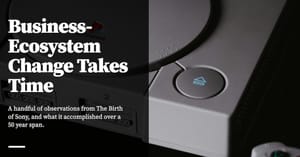See also the follow-up to this piece: Putting Perceptual Exposure to Practice.
One of the most important jobs in the egg industry is the job of the sexer: a human being who can quickly and accurately tell if a given chick is male or female. The earlier this is done, the quicker a chick can be put on the ‘optimise-food-for-eggs’ path, and the less likely a farm has to spend costly feed for male chicks.
Sexing is a lot tougher than it sounds, because chickens don’t have penises.
Chicken sexers are therefore one of the most lucrative jobs you can have in the poultry industry. They are the difference between a backyard egg farm and an industrial concern. This Pacific Standard article , for instance, says that sexers are ‘guarded like state secrets and paid like local gentry’ — starting at $60,000 a year.
The interesting thing about this story is how chicken sexers are taught. Imagine that you’re a sexer trainee, and you’re put in a room with 10,000 chicks, served to you in trays of 100. You’re asked to pick them up one at a time and put them in a tray marked ‘male’ or ‘female’; how do you learn to do this? Most people start out horribly: they turn a chick upside down, squeeze its bottom and … they can’t tell. They don’t know where to start.
The picture gets worse when you think about the end goal: a professional sexer can sort a thousand birds an hour with over 98% accuracy — one Hugh Grove from Oregon could hit 1500 an hour at his peak. How do you get from “it’s yellow and it doesn’t have a penis, what?” to an average of 0.5 seconds per chick?
If you think the answer is to sit a large group of people in a lecture theatre, maybe for a course titled “Chicken Sexing 101”, where an expert stands in front of an audience and describes just how to squeeze chicks — well, you’re wrong. Expert sexers can’t explain how they know. They just … do. And the people they train can’t explain it any better than they do.
The answer to this conundrum emerged in Japan in the 1920s. The Japanese figured out that expert chick sexers could pass on their expertise by giving trainees immediate feedback. They just had to do that for thousands of chicks, over a period of a few years.
New to Commoncog?
Commoncog is a publication about accelerating business expertise.
- Read the free business expertise series.
- Check out our guides.
- Listen to the podcast.
And join thousands of operators and investors reading our newsletter:
So, let’s imagine this: you’re a trainee sexer, you’re back in the room with 10,000 chicks. You grab one and … you guess — that is, you put it in a random tray, let's say the one marked FEMALE.
The expert immediately says: “no”.
You correct your mistake, put the chick in the male tray, and move to the next chick. You get this one right, but it feels totally random. This goes on for a long time.
A gajillion chicks later, you feel that something changes. You begin scoring better than random. Given enough time — courses at the Zen-Nippon Chick Sexing School are about two years long, so let’s say after two years of intensive sexing — you eventually hit 98% accuracy rates … and you still don’t know why. Your conscious mind thinks that it’s randomly selecting, but an invisible force guides your hand to the right tray.
This learning technique is called perceptual exposure — and it’s part of the puzzle of how experts gain expertise.
Perceptual Exposure as Natural Learning Strategy
A quick digression.
When I was an intern at Viki, I worked with a bunch of software engineers who took their chosen craft of programming very seriously. Viki at the time — pre-acquisition, engineers crammed into a small office on the first floor of an old Chinese shophouse in downtown Singapore — practiced what is known as pair programming: two software engineers to a computer, one typing, the other observing, both constantly engaged in a back-and-forth conversation.
Near the end of my internship, we found that we had too much work to do and too few engineers to do it with, so I was asked to code a set of API endpoints on my own. I completed my task and asked a senior engineer to look at my code — he walked over, glanced at my controller file, and said “Oh, that’s not good, this would be a problem later. Structure it this way.”
It was less than a few seconds at most, scrolling through the hundred or so lines I’d written. After a few minutes of back-and-forth, I conceded that his approach was better. “But how did you know to do that?” I asked.
The senior engineer launched into another explanation of controller patterns, and software engineering principles and —
“No,” I said, “Sorry, I mean, how did you know what the right approach was within five seconds of looking at my stuff?”
“Well,” he said, “It just felt right. Ok, let’s go to lunch, you can fix it afterwards.”
I remember feeling perplexed — the purpose of my internship was to learn to be a better software engineer; how could I learn to do that if my senior engineers couldn’t explain their inner processes in an articulate manner? I swore to become the kind of software engineer who could explain their internal thinking to interns in the future.
It was a few more years before I realised this was not doable.
If you were to put me in the same situation as the senior engineer today, I probably would be able to do as he did. The controller file was badly structured; it wouldn’t have taken long for an experienced software engineer to see that the code would lead to further problems down the road.
But if you were to ask me how I could judge so quickly, and how I gained this ability — this is a vastly more difficult task. It’s tempting to think that if I just sat down and concentrated hard enough, I would be able to externalise the thinking processes necessary to wield this knowledge. But I don’t think that’s possible.
I’ve spent a lot of time on Commonplace talking about how a lot of expertise is tacit knowledge — that is, knowledge that can’t be explicitly communicated. I’ve argued that the mental models worth learning are the tacit ones, and that you should beware non-practitioners attempting to teach what they don’t have the experience for. I’ve also argued that trial and error is a powerful, underrated learning strategy, because it lets reality be the teacher.
This isn’t about any of these things.
Perceptual exposure is a learning technique, one that I’d not heard about before. If you’re like me, and you have a passing interest in the learning science or expert performance literature, you’re probably aware of of ‘deliberate practice’ — the form of practice that best predicts expert performance, made popular by psychologist Anders Ericsson.
But you might not have heard of perceptual learning — a technique designed to teach knowledge that cannot be explicitly described. Perceptual learning isn’t as powerful as deliberate practice — Ericsson and his peers have shown that a large component of expert performance is attributable to deliberate practice — but it does tell us a few things about how humans learn.
Applied Perceptual Learning
I’ve spent a few days digging into the perceptual learning literature. What I’ve found is that while the effect has been known for decades — see this 1987 paper by Biederman and Shiffrar on chicken sexing and perceptual learning, for instance — the research into learning applications have been relatively limited.
It could be possible that I’ve been using the wrong keywords, though: in 1942, during World War II, Samuel Renshaw used perceptual exposure to teach friend-or-foe aircraft recognition to the navy , but his paper on the subject makes no mention of the phrase ‘perceptual learning’.

Across the pond and at around the same time, England was desperate for expert spotters in service of detecting German planes on their bombing runs. Eventually, the British government identified a few expert civilian spotters, and asked them to train others. Neuroscientist David Eagleman writes about this episode in his book Incognito, the Secret Lives of the Brain:
It was a grim attempt. The spotters tried to explain their strategies but failed. No one got it, not even the spotters themselves. Like the chicken sexers, the spotters had little idea how they did what they did — they simply saw the right answer.
With a little ingenuity, the British finally figured out how to successfully train new spotters: by trial-and-error feedback. A novice would hazard a guess and an expert would say yes or no. Eventually the novices became, like their mentors, vessels of the mysterious, ineffable expertise.
It’s clear from these stories that perceptual learning as a teaching technique has been known to some occupational psychologists. But perhaps the effect simply hasn’t made a splash the way deliberate practice has, thanks to a lack of research.
The paper that made contemporary perceptual learning exciting again was a relatively recent one: a 1994 presentation on pilot training by UCLA cognitive psychologist Phillip Kellman and NASA researcher Mary Kaiser. In the paper, they described the use of two ‘perceptual learning modules’, or PLMs — the first of which was an experiment where they gave a group of non-pilots a flight instrument panel, and less than five minutes of actual instruction: that is, a quick description of the task, and a quick explanation of the dials in a standard airplane panel.
The researchers then left these non-pilots with a series of repeated perceptual exposure exercises with feedback. The actual training consisted of two sessions, each under an hour. Participants were instructed to select from a list of seven possible interpretations for each presented instrument display:
- Straight and level
- Straight climb
- Straight descent
- Level turn
- Climbing turn
- Descending turn
- Instrument conflict (malfunction)
They did this for a total of 216 trials, divided into 9 blocks of 24 trials per block. Feedback on accuracy and speed was only given at the end of each block.
How did they fare? Kellman and Kaiser concluded:
PLMs (Perceptual Learning Modules) produced dramatic improvements in speed and accuracy for both non-pilots and pilots. Pilots initially outperformed non-pilots. Non-pilots after 1-2 hours of PLM training were as accurate and faster than pilots before training in both PLMs.
To put this into context, the ability to read standard cockpit instruments is a crucial piloting skill — often the difference between life and death. Experienced pilots can glance at an instrument panel and immediately extract enough information to know the plane’s situation. They must also be able to detect when instrumentation has failed — such as when multiple indicators give conflicting information. Conventionally instructed expert pilots have to have at least a thousand hours of experience before reaching their level of expertise.

In other words, non-pilots with no experience of flight, aeronautics and instrumentation matched experienced pilots with hundreds of hours of training, after only 120 minutes of perceptual learning!
This leads us to ask: how does this work? Why does perceptual exposure work as well as it does?
The Rules of Perceptual Learning
Perceptual exposure works because it leverages the brain’s ability to detect underlying patterns and structure. In simple terms: given a large set of superficially different examples, the brain will pick out that which does not vary.
This comes with a number of caveats.
The first caveat is that the knowledge learnt by perceptual exposure is task-specific. You can’t use the perceptual learning task designed for pilot instrumentation to learn submarine instrumentation. You can’t use the lessons developed for math problems to get better at chemistry homework.
The second caveat — and possibly the more interesting caveat for the purposes of our discussion here — is that perceptual learning is about tacit knowledge. Most learners were unable to articulate what they’ve learnt, and in many cases, did not actually ‘know’ that they had learnt something new. Often, improved performance in measured tasks was the only indication that learning had occured. UCLA researcher Emma Geller writes:
(…) perceptual learning is a process that most people can’t verbalize; even though we have evidence of significant improvement in processing information, our participants are not necessarily learning anything declarative or procedural. Future research will be directed towards testing the limits of what students can learn from tasks like our PLMs, but for the moment we don’t know how much conscious knowledge students are gleaning from the experience.
The best actionable summary of perceptual learning, however, comes from author, programming instructor, and former game developer Kathy Sierra. In her 2015 book Badass: Making Users Awesome, Kathy documents the requirements for effective perceptual learning in the service of creating better, more usable, more learnable products.
The key, Sierra says, is to show users a large number of diverse, positive examples within a compressed time.
The ‘large number of diverse examples’ are properties that we’ve covered before — you want to take advantage of the brain’s ability to pattern match. But why only ‘positive’ examples?
Sierra argues that it’s easiest to think of the brain is an automatic pattern-matching and mimicking device — one that learns from exposure. In simple terms: it typically learns best what it records the most.
This means that the best way to learn to spot ‘bad’ examples is by learning the underlying patterns and structures that show you the ‘good’.
Take language, for instance. If English is your first language, the sentence “play football I like to” should immediately set off alarm bells in your head. You don’t need to think in terms of grammatical rules to know that this sentence is wrong — your brain has already recorded the deep patterns of English, so you know you’re looking at a badly formed sentence by simple comparison with the recorded patterns in your head. This is the fruit of perceptual exposure in action.
Sierra continues:
This doesn’t mean we can’t teach using examples of bad, but the best, safest place for that approach is long after the learner develops strong perceptual knowledge for what’s good. Once they’re reliable at perceiving good, they’ll automatically recognize bad as “that which doesn’t fit the pattern” (even if they can’t explain why).

Perceptual Learning as ‘Experience’
Perceptual learning is interesting to me because it offers a credible explanation for the experience I had as a software engineering intern.
The ability to recognise good code and bad code is an example of perceptual exposure in action. When people say that you can have ‘taste’ in code, wine, photography or writing, what they actually mean is that you have to pick up certain deep patterns of ‘goodness’ in those subjects. When you hear practitioners saying that you have to ‘develop taste’ — the same way the senior engineer at Viki implied it when he said “oh, it felt right” to me — what this means is that you have to look at enough good code to get a feel for what works.
I suspect this effect is what is meant when writers say “read a lot, because if you want to write well, you must know what good writing looks like”.
This is what ‘gaining experience’ translates to.
And while the perceptual learning examples we’ve looked at have so far been of intense learning experiments conducted in compressed time spans, Sierra suggests that perceptual learning is the other half of expertise:
There are two common attributes among experts. Two things that people with high expertise did that others didn’t. Besides the right type of practice (Deliberate Practice), master performers did something else that didn’t feel like practice. In fact, they might not have known they were doing anything at all.
(…)
They were exposed to high quantity, high quality examples of expertise.
Where you find deep expertise, you find a person who was surrounded by expertise. The more you watch (or listen) to expert examples, the better you can become. The less exposure you have to experts or results of expert work, the less likely you are to develop expert skills.
An implication of this? A person who grows up in a ‘musical’ family has an edge: he or she was exposed to ‘good’ examples of music from an early, early age.
Fin
One of the most persistent criticisms I got from my friends when I wrote The Mental Model Fallacy was that tacit knowledge — if it exists — is impossible to elucidate, and therefore, impossible to teach.
But I never really made this argument. While tacit knowledge is — by definition — not externalisable — I did not actually say that tacit knowledge was unteachable. In fact, I argued that the truly valuable mental models were the tacit ones. I implied that they were learnable, and that we should make those the object of our pursuits — which necessarily means going after actual practitioners, and learning in the same way that an apprentice can learn from a master, or in the same way that successful Chinese businessmen teach business to their successors.
Perceptual exposure is a perfect example of learning tacit knowledge. It is one of the few learning techniques that skips the translation to language, and leaps straight to embedded know-how in the human brain. As an idea, it provides colour and light to the instruction to ‘go get some experience’. It hints to us at how building taste occurs.
And the best thing about it is that it’s not even magic. It’s how babies learn to talk. It’s how I learnt to write and to code. Perceptual learning is nothing special: it is simply how our brains work.
Here's a follow-up to this piece: Putting Perceptual Exposure to Practice.
Originally published , last updated .
This article is part of the Expertise Acceleration topic cluster. Read more from this topic here→





